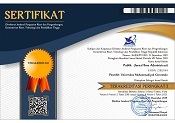Tourism Branding as Government Support to Increase Economic Country: Social Network Analysis
Abstract
The Indonesian Government seeks to invest in digital communications to strengthen Indonesia's tourism industry and position it as a leading tourist destination. Social media enables organizations to provide personalized and engaging information to communities or individuals efficiently and effectively. Therefore, this study aims to discover how the Indonesian government uses social media (Twitter) to create images that can help boost tourism and the economy after COVID-19. This study uses social network analysis to explain information distribution and interaction. This study analyzes social media networks for promoting and branding Indonesian tourism using a qualitative descriptive and theoretical approach. To visualize data analysis, the Nvivo 12 Plus software, specifically the Twitter Sociogram and Netlytics dataset tools, highlights the results of Social Network Analysis regarding interactions using the hashtag #WonderfulIndonesia. According to the study's findings, the Indonesian government uses Twitter as a means of communication and promotion to improve tourism's image or branding, which is likely to be effective. By mentioning the #WonderfulIndonesia hashtag, government accounts promote tourism branding by disseminating information to the public, private sector, and others. The use of social media in large-scale tourism branding activities to attract tourists and improve the nation's economy is usually accompanied by strict management. In addition, support from various stakeholders is needed because it is proven that the government, as a single actor, has limitations in increasing tourism sector revenue through branding.
Keywords
Full Text:
PDFReferences
Adrian, M. M., Nurmandi, A., Muallidin, I., & Purnomo, E. P. (2022). Social Network Analysis: How Twitter Social Media Used in Raising Tax Awareness During the COVID-19 Pandemic (pp. 331–339). https://doi.org/10.1007/978-3-031-06391-6_43
Aftab, S., & Khan, M. M. (2019). Role of Social Media in Promoting Tourism in Pakistan. Journal of Social Sciences and Humanities, 58(1), 101–113. https://doi.org/10.46568/jssh.v58i1.131
Camacho, D., Panizo-LLedot, Á., Bello-Orgaz, G., Gonzalez-Pardo, A., & Cambria, E. (2020). The four dimensions of social network analysis: An overview of research methods, applications, and software tools. Information Fusion, 63(1), 88–120. https://doi.org/10.1016/j.inffus.2020.05.009
Damiasih, D., & Isdarmanto, I. (2019a). The Role of Multimedia in Developing Ecotourism Branding of Yogyakarta Special Region (DIY). TRJ Tourism Research Journal, 3(2), 116. https://doi.org/10.30647/trj.v3i2.57
Damiasih, D., & Isdarmanto, I. (2019b). The Role of Multimedia in Developing Ecotourism Branding of Yogyakarta Special Region (DIY). TRJ Tourism Research Journal, 3(2), 116. https://doi.org/10.30647/trj.v3i2.57
Dyahati, D. B., Syaufina, L., & Sunkar, A. (2020). Disaster-Aware Tourist Development Strategy in Puncak Areas Bogor District West Java Province. Jurnal Pengelolaan Sumberdaya Alam Dan Lingkungan (Journal of Natural Resources and Environmental Management), 10(4), 639–649. https://doi.org/10.29244/jpsl.10.4.639-649
Jaipuria, S., Parida, R., & Ray, P. (2021a). The impact of COVID-19 on tourism sector in India. Tourism Recreation Research, 46(2), 245–260. https://doi.org/10.1080/02508281.2020.1846971
Jaipuria, S., Parida, R., & Ray, P. (2021b). The impact of COVID-19 on tourism sector in India. Tourism Recreation Research, 46(2), 245–260. https://doi.org/10.1080/02508281.2020.1846971
Jimenez-Marquez, J. L., Gonzalez-Carrasco, I., Lopez-Cuadrado, J. L., & Ruiz-Mezcua, B. (2019). Towards a big data framework for analyzing social media content. International Journal of Information Management, 44(September 2018), 1–12. https://doi.org/10.1016/j.ijinfomgt.2018.09.003
Lin, C. H., & Kuo, B. Z. L. (2018). The moderating effects of travel arrangement types on tourists’ formation of Taiwan’s unique image. In Tourism Management (Vol. 66, Issue January). https://doi.org/10.1016/j.tourman.2017.12.001
Loss, L. (2019). Tourism has Generated 20% of Total World Employment Since 2013. Tourism Review News.
Mahdi, M. I. (2022). Pengguna Media Sosial di Indonesia Capai 191 Juta pada 2022. Dataindonesia.Id.
Menegaki, A. N. (2020). Hedging feasibility perspectives against the COVID-19 in the international tourism sector. Journal of Chemical Information and Modeling, April, 1–18. https://doi.org/10.20944/preprints202004.0536.v1
Purnomo, E. P., Fathani, A. T., Kasiwi, A. N., & Tenorio, C. B. (2022). How Does Government Policy Support Sustainable Tourism in Dealing with COVID-19 Pandemic. Journal of Sustainability Science and Management, 17(2), 170–186.
Satgas COVID-19. (2022). Peta Sebaran Kasus per Provinsi. Covid19.Go.Id.
Similarweb. (2022). Similarweb Adoption by Analyze Website. Similarweb.
Statista. (2022). Number of social media users worldwide from 2018 to 2027. Statista.
Sundari, C., Nurmandi, A., Muallidin, I., Kurniawan, D., & Salahudin. (2022). Analysis of Secondary Education Services During the COVID-19 Pandemic. In Lecture Notes in Networks and Systems (Vol. 319). Springer International Publishing. https://doi.org/10.1007/978-3-030-85540-6_123
Ulfa, K., Zaenuri, M., Rahmawati, D. E., Rassanjani, S., Mukhrijal, M., & Imanullah, A. (2021a). Branding Strategy “The Light Of Aceh” Through E-Tourism On Sustainable Tourism Development in Aceh Province. Journal of Governance and Public Policy, 8(3), PROGRESS. https://doi.org/10.18196/jgpp.v8i3.11034
Ulfa, K., Zaenuri, M., Rahmawati, D. E., Rassanjani, S., Mukhrijal, M., & Imanullah, A. (2021b). Branding Strategy “The Light Of Aceh” Through E-Tourism On Sustainable Tourism Development in Aceh Province. Journal of Governance and Public Policy, 8(3), PROGRESS. https://doi.org/10.18196/jgpp.v8i3.11034
UNWTO. (2017a). UNWTO Tourism Highlights: 2017 Edition (2017th ed.). World Tourism Organization (UNWTO).
UNWTO. (2017b). UNWTO Tourism Highlights: 2017 Edition (2017th ed.). World Tourism Organization (UNWTO).
Vecchio, P. Del, Mele, G., Ndou, V., & Secundo, G. (2018). Creating value from Social Big Data: Implications for Smart Tourism Destinations. Information Processing and Management, 54(5), 847–860. https://doi.org/10.1016/j.ipm.2017.10.006
Wang, Y., Xi, M., Chen, H., & Wu, X. (2022). A social network analysis of tourism cooperation in the Yangtze River Delta: A supply and demand perspective. PLOS ONE, 17(2), e0263411. https://doi.org/10.1371/journal.pone.0263411
WTTC. (n.d.). World Travel & Tourism Council (WTTC) represents the Travel & Tourism sector globally.
Wu, S., Chen, T., Wu, Y., & Lytras, M. (2018). Smart Cities in Taiwan: A Perspective on Big Data Applications. Sustainability, 10(2), 106. https://doi.org/10.3390/su10010106
Wu, S. M., Chen, T. chun, Wu, Y. J., & Lytras, M. (2018). Smart cities in Taiwan: A perspective on big data applications. Sustainability (Switzerland), 10(1), 1–14. https://doi.org/10.3390/su10010106
Zaenuri, M., Eviany, R., & Fridayani, H. (2019). Strengthening Network-Based Regional Tourism: A Case Study of Network Between Sleman Regency Government and PT. Cikal Bintang Bangsa at the Festival of Light Kaliurang. 353(IcoSIHESS), 513–519. https://doi.org/10.2991/icosihess-19.2019.89
Article metrics
Refbacks
- There are currently no refbacks.
Copyright (c) 2023 Publik (Jurnal Ilmu Administrasi)

This work is licensed under a Creative Commons Attribution-ShareAlike 4.0 International License.

Publik (Jurnal Ilmu Administrasi) is licensed under a Creative Commons Attribution-ShareAlike 4.0 International License.










